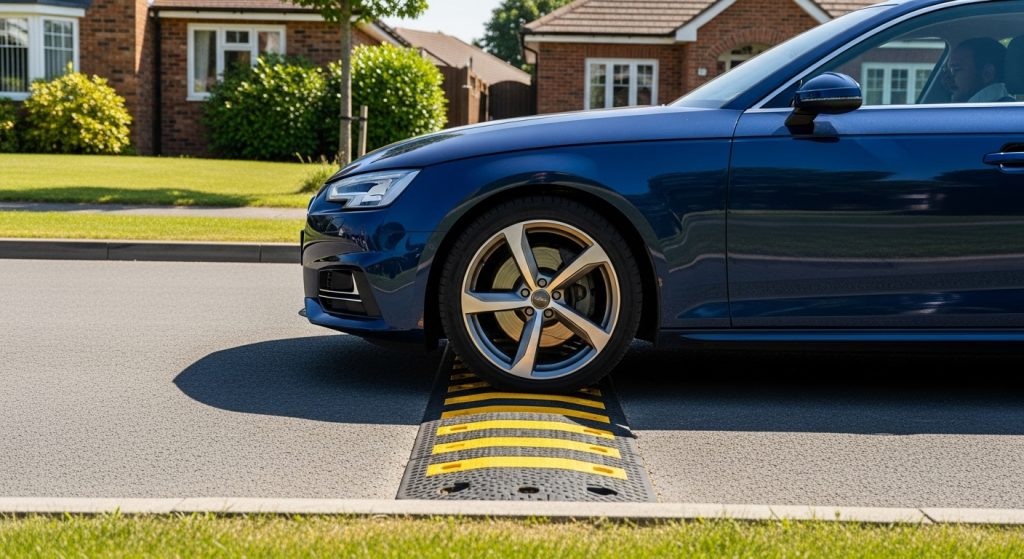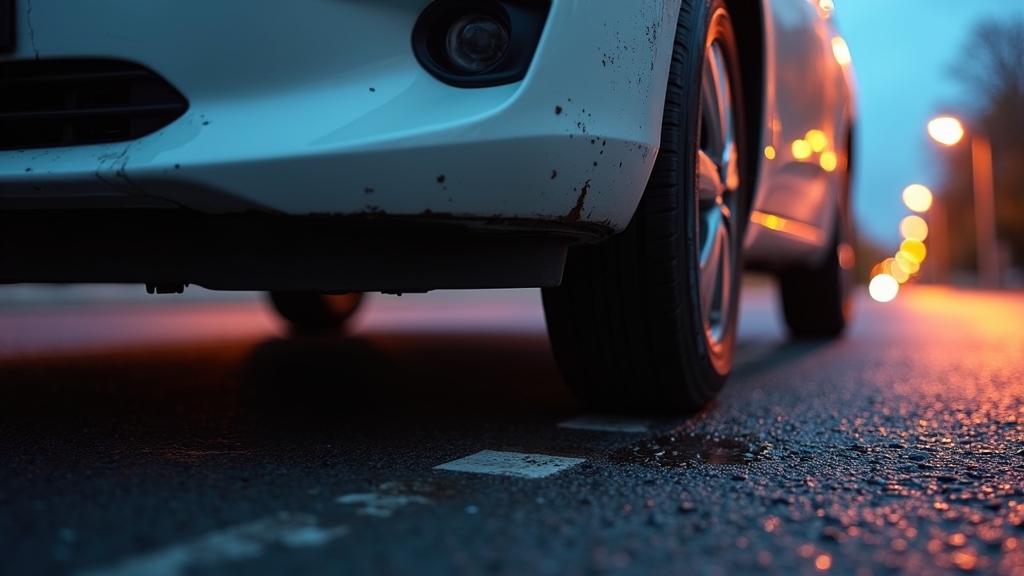You can damage your car if you hit a speed bump too fast or if your vehicle has low clearance. Suspensions endure repeated shocks, risking worn shocks, bent control arms, and tire sidewall damage.
Underbody parts like oil pans or exhausts can scrape or dent. Proper speed, around 5–10 mph, and compliant bump design reduce risks markedly. To avoid costly repairs and maintain safety, you should understand how speed, design, and driving technique influence potential damage.
Key Takeaways
- Speed bumps can cause suspension wear, tire damage, and underbody scrapes if crossed at high speeds or with improper vehicle clearance.
- Driving over speed bumps above 20 mph increases the risk of shocks, struts, and springs deteriorating prematurely.
- Low-clearance vehicles are more susceptible to undercarriage damage like oil pan dents and exhaust system scrapes.
- Properly designed speed bumps (3–6 inches height, gentle slopes) and slow speeds reduce vehicle damage risks.
- Repeated impacts from speed bumps can lead to costly repairs and compromised vehicle safety over time.
How Speed Bumps Affect Vehicle Components?

When you drive over speed bumps, your vehicle’s suspension system immediately absorbs vertical forces that compress components like shocks, struts, and springs. These forces cause repeated compression and extension cycles, which accelerate wear on shock absorbers and springs, leading to reduced damping efficiency and sagging suspension.
The anti-roll bars also play a crucial role in maintaining vehicle stability but can suffer wear or damage from these impacts. Proper maintenance and timely replacement of affected parts help ensure driving comfort.
Control arms and bushings also experience increased strain, risking premature failure and compromised steering stability. High-speed impacts can bend suspension parts, dislodge bushings, and misalign wheels, negatively affecting handling and ride comfort.
Additionally, shocks and struts may leak or deform, undermining their ability to maintain tire contact with the road. By slowing down, you allow these components to operate within design limits, preserving suspension integrity and vehicle control over time.
Common Types of Damage Caused by Speed Bumps
You risk accelerating suspension wear and tire damage when you hit speed bumps too fast, causing misalignment, bulges, and premature failure. These impacts can also lead to increased maintenance costs due to the accelerated wear on suspension components.
Scrapes and impacts to the undercarriage can dent oil pans and exhaust components, especially if your vehicle clearance is low. Using the correct viscosity gear oil in your drivetrain can help maintain smooth operation despite such impacts.
Understanding these common damage types helps you mitigate repair costs and maintain vehicle safety.
Suspension and Tire Damage
Although speed bumps serve to control traffic speed, they impose significant mechanical stress on a vehicle’s suspension and tires that can lead to accelerated wear and damage. Repeated jolts strain shock absorbers and struts, causing premature seal failure and hydraulic leaks, which degrade damping performance.
Using proper driving techniques can help reduce impact stress and prolong suspension life.
Springs and control arms risk bending or loosening, while mounting bolts may loosen, increasing mechanical failure hazards. Tires endure impacts akin to potholes, risking sidewall bulges, cuts, and tread separation.
Damage from speed bumps can lead to liability for councils if specifications are not met, highlighting the importance of proper installation.
These shocks also cause uneven tire wear and can misalign suspension geometry, compromising handling and safety. Driving too fast over speed bumps exacerbates these effects, raising maintenance costs by hundreds annually.
Regular use of alignment checks is critical in identifying and correcting suspension misalignments early. Regular alignment checks and moderated speeds are critical in mitigating suspension and tire damage caused by speed bump encounters.
Scrapes and Underbody Impact
Since speed bumps often have insufficient clearance for many vehicles, scrapes and underbody impacts are frequent sources of damage. You risk scraping low-hanging components like bumpers, side skirts, and rocker panels, which removes paint and exposes metal, accelerating corrosion.
Repeated impacts can weaken plastic parts, causing cracks or chips. Underbody protective plates may dent or bend, compromising their shielding function and increasing vulnerability of essential elements such as oil pans and transmissions.
Such damage may also lead to mechanical failures due to structural impacts. Regular inspection and maintenance are crucial to prevent long-term deterioration caused by these impacts.
Damaged panels can loosen, causing rattling and secondary harm. Fluid systems, including oil pans and brake lines positioned low, risk punctures or leaks, threatening engine performance and safety. Exhaust components suffer dents or broken mounts, reducing efficiency and causing noise.
Structural scrapes expose chassis metal, promoting rust that undermines frame integrity and raises repair costs. Salt accelerates corrosion, making maintenance more challenging and costly over time. Using protective coatings can help reduce corrosion risk after damage occurs.
The Role of Driving Speed in Speed Bump Impact

When drivers fail to reduce speed adequately before speed bumps, their vehicles endure increased mechanical stress that leads to accelerated suspension wear, tire damage, and potential control loss. Proper maintenance, including timely brake fluid changes, plays a crucial role in overall vehicle safety and performance.
Driving over speed bumps at speeds exceeding 45 mph substantially magnifies shock transmission, risking suspension component failure and tire blowouts.
Conversely, maintaining a controlled speed of 5-10 mph allows gradual shock absorption, preserving vehicle integrity. In fact, speed bumps are designed to slow traffic to about 20mph to prevent such damage.
Consider these impacts of excessive speed:
- Suspension systems experience severe jolts, accelerating wear or causing sudden failure.
- Tires risk blowouts due to abrupt vertical impacts, compromising safety and control.
- Repeated high-speed impacts loosen undercarriage components, increasing repair frequency and costs.
Thus, precise speed management directly reduces mechanical damage and enhances vehicular safety when negotiating speed bumps. Regular vehicle inspections and use of high-quality components, such as Castrol SRF brake fluid, further ensure reliability under stress.
Design Standards and Height Regulations for Speed Bumps
You need to adhere to maximum height limits, typically between 3 to 6 inches, to prevent vehicle undercarriage damage.
Ignoring design standards amplifies the risk of suspension issues and legal liability.
Understanding these guidelines ensures speed bumps balance safety with drivability effectively.
Proper design also involves considering technical specifications to maintain consistency and reliability in road safety features.
Maximum Height Limits
Although no universal maximum height limits exist for speed bumps, design standards generally keep their height between 3 and 6 inches to balance speed control effectiveness with vehicle safety.
You’ll find most speed bumps on private property reaching up to 6 inches, while speed humps on public roads stay closer to 3–4 inches to reduce vehicle impact. Proper maintenance and durability considerations help ensure speed bumps remain effective without causing unnecessary damage.
To prevent damage, vertical lips mustn’t exceed 0.25 inch, and slope ratios range from 1:10 to 1:25 for smooth progressions. Additionally, speed humps are designed with careful placement to ensure they are located where visibility and lighting are adequate.
Consider these key parameters:
- Height: 3–6 inches for speed bumps; 3–4 inches for speed humps.
- Lips: Max 0.25 inch to avoid undercarriage strikes.
- Slopes: Side slopes no steeper than 1:6 for safe crossing.
These limits optimize safety while limiting vehicle wear.
Impact of Non-compliance
Since adhering to design standards and height regulations is essential, failing to comply can expose municipalities and drivers to significant risks. Installing speed bumps without statutory authority or on roads exceeding 30 mph contravenes regulations, increasing legal liabilities.
Proper slope ratios between 1:10 and 1:25 are crucial to ensure safety and comfort for drivers and passengers. Regular maintenance and inspection of road safety devices help prevent unexpected hazards caused by wear or damage.
Non-compliance with MUTCD signage requirements compromises driver preparedness, raising accident and vehicle damage probabilities.
Structurally, exceeding recommended height limits or using improper slopes results in harsh impacts that damage suspensions and undercarriages. Poor placement such as near driveways or with improper spacing disrupts traffic flow and reduces speed control effectiveness, leading to unsafe braking and increased wear.
Operationally, arbitrary installations without performance audits can cause driver frustration and evasion behaviors. Ensuring proper installation aligns with safety gear and precautions recommended for vehicle modifications to minimize risks.
Design Guidelines Overview
When designing speed bumps, adhering to strict dimensional and regulatory standards is essential to balance traffic calming effectiveness with vehicle safety. Choosing materials and designs that minimize vehicle wear can improve long-term durability and reduce maintenance.
You must ensure speed bumps fall within a height of 3 to 4 inches, with widths between 12 and 23 feet to cover standard lanes. Their slope ratios, ranging from 1:10 to 1:25, reduce vehicle impact and discomfort.
Consider these critical design parameters:
- Height shouldn’t exceed 6 inches to avoid excessive vehicle damage risk.
- Placement suits streets with speed limits of 25-30 mph and grades under 5%. Proper placement ensures compatibility with typical maintenance intervals and vehicle operating conditions.
- Warning signs per MUTCD standards must precede speed bumps for driver alertness. Additionally, side slopes on tapers must not exceed a ratio of 1:6 to ensure safety and effectiveness.
Following these guidelines helps maintain safety, effectiveness, and regulatory compliance while minimizing potential car damage.
Financial Implications of Speed Bump Damage on Drivers
If you drive frequently on urban roads, you might face a significant risk of speed bump-induced car damage, with about 22% of UK drivers reporting such incidents. The average repair cost hovers around £141, primarily involving tyres (50%) and suspension components (33%).
Repair expenses vary widely, from £50 to over £250, depending on damage severity. Repeated impacts accelerate maintenance needs, increasing costs by $200 to $400 annually based on vehicle type. Vehicles with higher clearance or crossover designs handle bumps better, influencing car choice vehicle clearance benefits.
Undetected damage risks costly repairs affecting safety-critical parts. Insurance claims often aren’t cost-effective due to typical deductibles exceeding repair costs, leading you to bear out-of-pocket expenses.
Additionally, avoiding speed bump-laden routes can raise fuel and travel costs. Electrical or mechanical issues caused by such damage can also affect your vehicle’s heating and other systems, increasing repair complexity.
Overall, speed bump damage imposes tangible financial burdens, influencing your maintenance budgeting and driving decisions.
Liability and Compensation Related to Speed Bump Damage

You need to understand that local authorities generally bear responsibility for speed bump installation and maintenance, which directly affects your claim eligibility. Proper signage and visibility are crucial elements that municipalities must maintain to prevent accidents and damage.
Establishing liability requires proving negligence in design, marking, or upkeep, alongside meeting jurisdictional claim criteria. From there, you must follow specific procedural steps to document damages and navigate compensation processes effectively.
This includes adhering to the Florida Tort Claims Act’s filing deadlines and damage caps to ensure your claim is valid.
Local Authority Responsibility
Although local authorities design and install speed bumps to enhance road safety, they can be held liable if these installations cause vehicle damage or personal injury due to negligence or failure to meet established safety standards.
Your claim hinges on proving improper installation, lack of maintenance, or noncompliance with regulations such as height limits and signage requirements.
Local governments often face challenges in liability claims because of sovereign immunity and statutory damage caps. However, they must act promptly to address known hazards.
For example, in San Francisco, a speed bump installed on Clay Street without warning signs caused injuries within just 10 days, leading to its quick removal by the city due to safety concerns speed bump removal.
Consider these key factors:
- Installation compliance: Was the speed bump built per national/local codes, including height and placement?
- Maintenance and signage: Has the authority maintained clear markings and repaired defects?
- Response to notifications: Did the local authority promptly mitigate reported issues to prevent damage or injury?
Understanding these aspects clarifies local authority responsibility in speed bump incidents.
Claim Eligibility Criteria
What determines your eligibility to claim compensation for speed bump-related vehicle damage? Primarily, it hinges on proving negligent design, installation, or maintenance. Speed bumps exceeding local height or slope standards or lacking proper visibility increase liability.
You must identify the responsible party—public authorities for public roads or private owners for private property. Contractors may share liability if substandard work is evident.
In cases involving government entities, you must demonstrate that the speed bump created an unreasonable hazard and that the government knew or should have known about the danger but failed to act, as required under the Illinois Tort Immunity Act.
To substantiate your claim, document the bump’s dimensions, signage, and road conditions alongside vehicle damage assessments. Expert evaluations and witness statements bolster your case. Insurance coverage depends on your policy; collision insurance might apply, but liability coverage rarely covers your vehicle damage. Prompt reporting and detailed accident records are critical.
Ultimately, eligibility revolves around demonstrating that despite careful driving, the improperly designed or maintained speed bump caused your damage.
Compensation Process Steps
When pursuing compensation for speed bump-related vehicle damage, the process begins with accurately identifying the responsible party, which usually involves determining whether a public authority or private owner maintains the speed bump. It is also important to verify if the speed bump complies with the legal maximum height of 100 mm, as exceeding this limit may establish liability.
Next, you must document the incident meticulously, capturing photographic evidence of the speed bump, vehicle damage, and signage conditions. Such evidence is crucial, especially if the speed bump was unmarked or lacked warning signs, which can contribute to the claim.
Then, obtain expert assessments proving the bump caused the damage, separating driver error from liability issues. Independent assessments can confirm the speed bump height and the nature of vehicle damage, strengthening the claim’s validity.
Finally, file a claim promptly, adhering to deadlines and legal requirements. Timely filing is essential to ensure that the claim is considered and to avoid dismissal due to procedural errors.
- Identify ownership and check compliance with regulatory standards. This includes checking for speed bump height compliance to determine if the bump exceeds legal limits.
- Collect detailed evidence: photos, witness statements, and repair estimates.
- Initiate and negotiate claims with supporting expert testimony and legal advice.
This structured approach optimizes your claim’s validity and maximizes potential compensation.
Safety Benefits Versus Vehicle Wear: Balancing Priorities
Because speed bumps play a critical role in reducing vehicle speeds and enhancing pedestrian safety, you must weigh these benefits against the potential for increased vehicle wear.
Speed bumps cut speeds by up to 40%, considerably lowering pedestrian-motorist crashes and reducing child injury risks by over 50%. This safety gain overwhelmingly outweighs moderate vehicle wear concerns.
However, damage potential varies with bump design, height, and driver behavior. Traditional, rigid bumps can stress suspension and undercarriage if crossed at high speeds, while rubber alternatives reduce shock impact. Proper placement and community education promote controlled speeds, minimizing wear. Proper planning and placement are essential for effectiveness and safety.
Ultimately, balancing these factors through careful planning and material choice ensures that the imperative of pedestrian safety remains paramount without causing undue vehicle damage.
Tips for Minimizing Car Damage When Approaching Speed Bumps
Although speed bumps are essential for safety, you can minimize potential car damage by controlling your speed carefully when approaching them. Maintaining a low speed, ideally around 3 MPH, reduces stress on your suspension and absorbs shocks effectively. Driving over speed bumps too quickly can cause rapid impacts that damage shocks and suspension components.
Additionally, crossing at a slight angle lessens simultaneous tire impact, protecting your chassis and undercarriage.
Finally, consider your vehicle’s load; heavier weights amplify forces on suspension components, so reducing cargo and evenly distributing weight helps.
- Slow down to about 3 MPH to minimize suspension compression and avoid jolts.
- Approach speed bumps at an angle to distribute impact forces and prevent scraping.
- Lighten and balance your load to reduce stress on shocks and tires during crossing.
These strategies analytically reduce wear and safeguard your vehicle’s structural integrity.
The Importance of Proper Signage and Driver Awareness
Ensuring proper signage and driver awareness plays a critical role in minimizing vehicle damage caused by speed bumps. When you encounter clearly visible signs featuring reflective materials, contrasting paint, and adequate lighting, you can reduce speed safely, lowering suspension and tire strain.
Properly designed speed bumps comply with height limits (max 100mm) to balance traffic calming and vehicle protection. Without such warnings, drivers often approach too quickly, increasing damage risk and abrupt braking.
Educating you on maintaining 5-10 mph before bumps further mitigates shocks to your vehicle. Dynamic warnings like flashing lights and rumble strips enhance your compliance by signaling upcoming speed control. Regular audits ensure signage effectiveness, reducing driver errors and associated damages.
It is important to remember that slowing to 5-10 mph reduces risk of vehicle damage when crossing speed bumps. Ultimately, your awareness and well-marked speed bumps work together to safeguard your car and improve road safety.
Local Authority Responsibilities in Speed Bump Installation
When local authorities evaluate the need for speed bumps, they follow strict criteria to balance traffic calming with safety and community impact. You’ll see they require strong residential support, typically 67% to 70%, and focus on local residential streets with speed limits at or below 25 MPH but documented speeding above 33 MPH.
They analyze physical street parameters to verify suitability and avoid drainage or safety issues. For instance, the street segment must be at least 1/4 mile long and predominantly residential to qualify for speed bump installation residential street criteria.
Key responsibilities include:
- Conducting traffic studies evaluating volume, speed, and accident history.
- Verifying engineering compliance with design standards, including height and placement.
- Coordinating with emergency services to prevent response delays.
This process ensures that speed bumps effectively reduce speed without compromising vehicle safety or emergency access.
Frequently Asked Questions
Are Certain Car Models More Prone to Speed Bump Damage?
Yes, certain car models are more prone to speed bump damage. If you drive a low-clearance sports car or sedan, you risk scraping and undercarriage harm. Stiff suspensions in sports models transfer impact forces, increasing wear, while older vehicles with worn components suffer accelerated damage.
SUVs and trucks might seem safer due to clearance but can still endure suspension wear if you don’t slow down properly. Adaptive suspensions help reduce this risk.
Can Speed Bumps Affect Vehicle Fuel Efficiency?
Coincidentally, hitting a speed bump doesn’t just jolt your suspension; it also spikes your fuel usage. You’ll see an increase of up to 38% in passenger cars because accelerating after each bump demands extra engine power.
This repeated stop-start pattern disrupts steady speeds, causing inefficient fuel consumption. So, every speed bump you cross adds to your fuel costs and emissions, making your drive less eco-friendly and more expensive over time.
How Do Weather Conditions Influence Speed Bump Damage Risk?
Weather conditions directly increase speed bump damage risk by altering material integrity and vehicle interaction. Cold temperatures cause cracks, while heat softens bumps, leading to uneven surfaces. Rain and ice reduce tire traction, raising slip and impact forces.
Freeze-thaw cycles accelerate deterioration, and UV exposure weakens materials over time. These factors amplify stress on your vehicle’s suspension and undercarriage, increasing the likelihood of damage when crossing speed bumps in varying weather.
Is It Safe to Remove or Modify Speed Bumps on Private Property?
Tweaking or bidding farewell to speed bumps on your private property isn’t a casual endeavor. You need to follow legal protocols, consult experts, and get community buy-in to keep things smooth and safe.
Ignoring these steps can lead to unexpected liabilities, increased speeds, and safety concerns.
Do Electric or Hybrid Cars Experience Different Impacts From Speed Bumps?
Yes, electric and hybrid cars experience different impacts from speed bumps.
Your EV’s low ground clearance and underfloor battery make it vulnerable to underbody damage if you cross bumps too fast.
Hybrids use advanced motor braking and electronic suspension to reduce pitch and bounce, protecting suspension and electronics.
However, both need careful speed management to avoid suspension wear, battery damage, or steering misalignment caused by improper speed bump traversal.
Drive Smart, Save Money: Avoiding Speed Bump Repairs
Think of speed bumps like hurdles on a track. If you hit them too fast, your car’s suspension takes the brunt, leading to costly repairs. Studies show that vehicles traveling over 15 mph experience up to 30% more wear on shocks and undercarriage components.
By slowing down and staying alert to signage, you safeguard your car’s integrity without sacrificing safety. Balancing speed and caution ensures both your vehicle and community stay in top shape.




